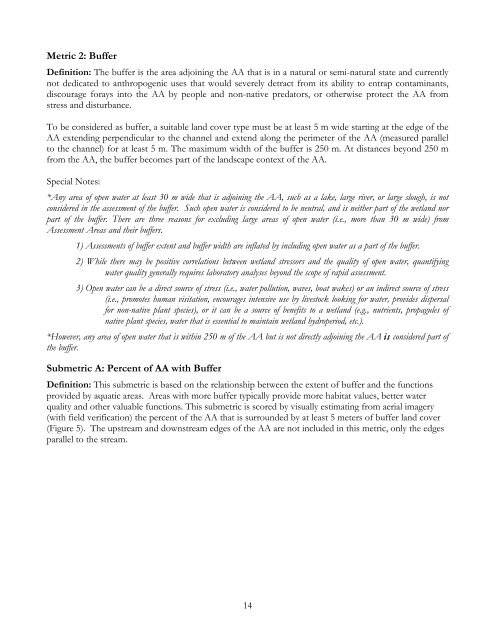Create successful ePaper yourself
Turn your PDF publications into a flip-book with our unique Google optimized e-Paper software.
Metric 2: Buffer<br />
Definition: The buffer is the area adjoining the AA that is in a natural or semi-natural state and currently<br />
not dedicated to anthropogenic uses that would severely detract from its ability to entrap contaminants,<br />
discourage forays into the AA by people and non-native predators, or otherwise protect the AA from<br />
stress and disturbance.<br />
To be considered as buffer, a suitable land cover type must be at least 5 m wide starting at the edge of the<br />
AA extending perpendicular to the channel and extend along the perimeter of the AA (measured parallel<br />
to the channel) for at least 5 m. The maximum width of the buffer is 250 m. At distances beyond 250 m<br />
from the AA, the buffer becomes part of the landscape context of the AA.<br />
Special Notes:<br />
*Any area of open water at least 30 m wide that is adjoining the AA, such as a lake, large river, or large slough, is not<br />
considered in the assessment of the buffer. Such open water is considered to be neutral, and is neither part of the wetland nor<br />
part of the buffer. There are three reasons for excluding large areas of open water (i.e., more than 30 m wide) from<br />
Assessment Areas and their buffers.<br />
1) Assessments of buffer extent and buffer width are inflated by including open water as a part of the buffer.<br />
2) While there may be positive correlations between wetland stressors and the quality of open water, quantifying<br />
water quality generally requires laboratory analyses beyond the scope of rapid assessment.<br />
3) Open water can be a direct source of stress (i.e., water pollution, waves, boat wakes) or an indirect source of stress<br />
(i.e., promotes human visitation, encourages intensive use by livestock looking for water, provides dispersal<br />
for non-native plant species), or it can be a source of benefits to a wetland (e.g., nutrients, propagules of<br />
native plant species, water that is essential to maintain wetland hydroperiod, etc.).<br />
*However, any area of open water that is within 250 m of the AA but is not directly adjoining the AA is considered part of<br />
the buffer.<br />
Submetric A: Percent of AA with Buffer<br />
Definition: This submetric is based on the relationship between the extent of buffer and the functions<br />
provided by aquatic areas. Areas with more buffer typically provide more habitat values, better water<br />
quality and other valuable functions. This submetric is scored by visually estimating from aerial imagery<br />
(with field verification) the percent of the AA that is surrounded by at least 5 meters of buffer land cover<br />
(Figure 5). The upstream and downstream edges of the AA are not included in this metric, only the edges<br />
parallel to the stream.<br />
14















